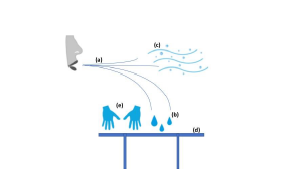Aerosol Impact Studies
“RISK ASSESSMENT OF A CORONAVIRUS INFECTION IN THE FIELD OF MUSIC” Spahn/Richter
The most relevant and comprehensive report we have seen so far comes from German researchers who are explicitly seeking to develop risk mitigation approaches for singing and instrument players of all types. While it is clear that key elements of the puzzle are still unknown this report gives a lot of considered proposals which may resonate with your choir members.
Generally, large numbers of people in small, indoor spaces are correlated with significant infection risk. These authors strongly favour outdoor musical activity. Provided the system is utilising 100% fresh air these authors consider ducted air conditioning systems to be the next best option.
“Cluster of Coronavirus Disease Associated with Fitness Dance Classes, South Korea” Sukbin Jang, Si Hyun Han, and Ji-Young Rhee
Research into a cluster of cases in South Korea relating to dance aerobic exercise sessions generates some interesting data that may be relevant to higher aerobic activities compared to talking. Researchers concluded that factors that may have contributed to the high levels of transmission between the infected instructors and their class members was relatively large numbers of people (classes of 20 had much higher infection rates while classes of 5 had none) in a relatively small room (60m2) undertaking high intensity activity. An infected instructor who taught Pilates and yoga in the same room (with a class size of 8) spread the virus to none of the class. The moist, warm environment of a sports complex coupled with turbulent air flow was also hypothesised as a contributing factor.
“Comparative dynamic aerosol efficiencies of three emergent coronaviruses” Fears, A.C. et al, Tulane School of Medicine
The ability of the COVID-19 virus to remain viable in aerosol form may be more significant than its SARS and MERS predecessors. In an, as yet non-peer reviewed comparative study, researchers concluded that:
“The comparison of short-term aerosol efficiencies of three emergent coronaviruses showed SARS-CoV-2 is on par with or exceeding the efficiency estimates of SARS-CoV and MERS-CoV. Some efficiency determinations for SARS-CoV-2 ranged to -5.5log10, a full log difference compared to MERS-CoV. The fact that higher efficiencies trended across independent laboratories strengthens this observation. These data suggest that SARS-CoV-2 generally maintains infectivity when airborne over short distances, in contrast to either comparator betacoronavirus. Results of the aerosol suspension experiments suggest that SARS-CoV-2 is persistent over longer periods of time than would be expected when generated as a highly respirable particle (2 μm MMAD). This is remarkable, as there would be an expected decay and loss in the infectious fraction of airborne virus based on prior susceptibility studies with other relatively environmentally hardy viruses like Monkeypox . A recent study , showing only a slight reduction of infectivity in aerosol suspensions with approximately similar particle sizes, were suggestive of the minimal effects on SARS-CoV-2 infectivity observed in these results.
Collectively, this preliminary dataset on the aerosol efficiency and persistence of SARS- CoV-2 suggest that this virus is remarkably resilient in aerosol form, even when aged for over 12 hours, and reinforces the conclusions reached in earlier studies of aerosol fitness by others . Aerosol transmission of SARS-CoV-2, whether through direct respiratory droplet transfer or fomite generation, may in fact be a more important exposure transmission pathway than previously considered . Our approach of quantitative measurement of infectivity of viral airborne efficiency complemented by qualitative assessment of virion morphology leads us to conclude that SARS-CoV-2 is viable as an airborne pathogen. Humans produce aerosols continuously through normal respiration . Production of aerosols increases during respiratory illnesses,and even during louder-than-normal oration . A fraction of naturally-generated aerosols fall within the size distribution used in our experimental studies (<5 μm), thus leading us to the conclusion that individuals infected with SARS-CoV-2 have the capacity to produce viral bioaerosols that may remain infectious over long periods of time after production via human shedding and airborne transport. Accordingly, our study results provide a basis for a broader recognition of the unique aerobiology of SARS-CoV-2, which may ultimately lead to tractable solutions and prevention interventions in the ongoing pandemic.”
“Testing the Efficacy of Homemade Masks Would They Protect in an Influenza Pandemic” A. Davies et al
The use of PPE to interrupt transmission of the virus is also an area with a lot of information but little clear data. The full report must be subscribed to but the abstract on a Cambridge University study into the effectiveness of face masks made from non-medical fabric (t shirt fabric for the most part) can be seen here.
- They are found to be about a third as effective as medical grade masks but a considerable improvement on nothing at all.
- Other research found that some readily available fabrics that were more effective than surgical masks but not as effective as N95 masks. An extract from that source summarises results as follows:
- “To test various masks and fabrics, the team pumped air through both types of face coverings.
- “Our instruments could read down to 0.3 microns, which is about the size of a big virus,” Segal said.
- Regular surgical masks filtered out 62 percent to 65 percent of particles. For comparison, N95 masks filter 95 percent of those particles.
- But the fabrics led to a variety of results. One piece of cloth filtered just 1 percent of particles, rendering it virtually useless, while others were found to perform even better than the surgical masks.
- “We had some that performed at 79 percent,” Segal told NBC News.
- The best masks were constructed of two layers of heavyweight “quilters cotton” with a thread count of at least 180, and had thicker and tighter weave.”
Respiratory virus shedding in exhaled breath and efficacy of face masks Nancy H. L. Leung et al
This paper published in Nature Medicine studied seasonal human coronaviruses, influenza viruses and rhinoviruses in exhaled breath and coughs of children and adults with acute respiratory illness. Tests were done with and without surgical type masks. The paper showed much better results for using masks against coronaviruses compared to influenza viruses. The following is an excerpt from the discussion;
“Our findings indicate that surgical masks can efficaciously reduce the emission of influenza virus particles into the environment in respiratory droplets, but not in aerosols….. We also demonstrated the efficacy of surgical masks to reduce coronavirus detection and viral copies in large respiratory droplets and in aerosols. This has important implications for control of COVID-19, suggesting that surgical face masks could be used by ill people to reduce onward transmission.”


